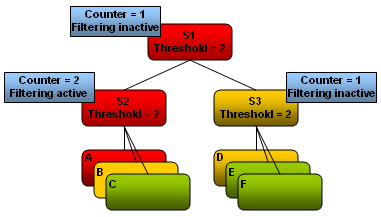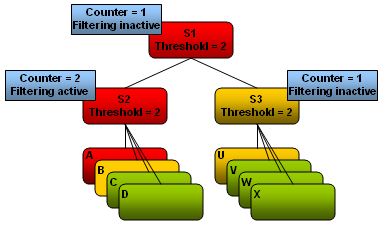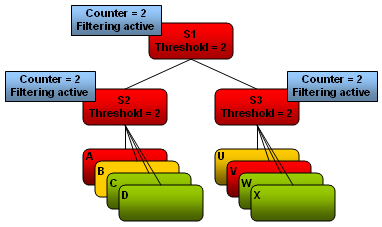Alarm filtering
With the help of the Alarm filtering you can set a limit value that specifies after how many individual alarms only the sum alert instead of the individual alarms is shown in the alarm screen. If you would, for example, define the limit value 4 and there would be 4 alarms of this sum alert, only the sum alarm would be shown in the alarm screen.
To activate the WinCC OA alarm filtering, proceed as follows:
- The alarm filtering is activated by default (set the config entry activateAlertFiltering = 0 in the [general] section of the config file to disable the alarm reduction).
-
Choose the option Threshold filter for the alarm filtering on the Filter types tab of the panel Properties of alert panel that is opened through the alarm screen.
CAUTION:The alarm filtering (Threshold filter) option can be used in the current mode. It cannot be used in the open mode of the alarm screen.
Figure 1. "Filter Types" Tab of the Panel Properties of "Alarm Panel" 
- Specify the threshold filter (value limit) in the alarm handling of a sum alarm in the PARA module. The threshold filter parameter can only be specified for deactivated sum alarms.

In the PARA module you can additionally specify that a sum alarm is shown although the limit value has not been exceeded (individual alerts are hidden in the alert screen). For this, activate the filter check box (see figure above) of a sum alarm handling. If the "Filter" is used, the DP list is not being used.
Example of alarm filtering
For a sum alert an alarm class can be specified. The sum alarm is only triggered when the single alarm has the same alarm class as the sum alarm.
The alarm filtering can also be used if an alarm class was not specified for a sum alarm.
- In this case two sum alarm are created w1_turbine1.sumalarm1 and w2_turbine1.sumalarm2.

Below you can find the sum alarm handling for the two sum alarms.




- A single alarm w1_turbine1.inOperation is triggered with the alarm class A.
- The both sum alarms are triggered.
- A single alarm w2_turbine1.inOperation is triggered with the alarm class B.
- For Sum alarm w1_turbine1.sumalarm1 the filter criterion (threshold) is now used. (2 alarms).
- Sum alarm w2_turbine1.sumalarm2 does not use the filter criterion (only one alarm exists with the alarm class "A").
- A single alarm w2_turbine1.current with alarm class A is triggered.
- For the sum alarm w2_turbine1.sumalarm2. the filter criterion is now used (2 alarms with alarm class A).
Sum alarm in Sum alarm (Cascaded Sum alarms)
WinCC OA supports the configuration of sum alarms in sum alarms with the same threshold without showing them in the alarm screen multiple times. In this case there is talk of cascaded sum alarms, which means that alarm reduction works in hierarchies (of more than one level).
The following rules have to be considered:
- A sum alarm with a threshold counts only its subordinated active (sum) alarms. An alarm is active, if a warning or an alarm is triggered (see A, B, D in figure below). A sum alarm
is active when it has reached its threshold (see S2 in figure below).

- Once the threshold of a sum alarm is reached, the summary alarm filters the active alarms of their subordinated sum alarms and shows itself instead (alerts are triggered as hitherto). According to the figure above S2 and D are shown.
- For the filtering only the active subordinated alarms of a sum alarm with a threshold are counted. From the figure above for the sum alarm S2 these alarms are A, B and C and for the sum alarm S3 these alarms are D, E and F.
- Alarms, which are subordinated to a sum alarm, are not counted/filtered by the sum alarms, which are superordinated to this sum alarm. From the figure above S1 does not count the alarms A, B, C, D, E and F.

The sum alarm S1 contains the sum alarms S2 and S3.
All sum alarms have the same threshold (=2).
A, B and U are active alarms.
S2 and U are shown.
S2: Threshold reached => children are filtered.
U: Its father has not reached the threshold, yet.
S1 is also not shown, because its threshold is not reached. Although the S3 sum alarm is active, since U is active, however, it is not counted by S1, because its threshold has not been reached, yet.

A, B, U and V are active alarms.
S1 is shown.
S1: threshold reached => children S2 and S3 are filtered.
S2: filters its children, but is not shown, since it is also filtered by its father S1.
S3: filters its children, but is not shown, since it is also filtered by its father S1.
Sum alarm details
The sum alarm details panel opens by right-clicking on a sum alarm in the alarm screen.

The column "Filtered" shows if an alarm has been filtered, meaning whether the alarm filtering has been used. As shown before, you can set a threshold filter parameterfor the sum alarms on the Alerts tab of a sum alarms handling (in the PARA module). The filter can be used to specify after how many individual alarms only the sum alarm should be shown (alarm filtering). Thesum alert detailspanel, however, shows the individual alarms and whether the alarms were filtered. That is, whether the threshold parameter has been used or not.
The checkbox "Filter" of a sum alarm handling (in the PARA module) can be used to hide individual alarms of an active alarm (to force a single alarm to be filtered). In this way, only the sum alarm would be shown although the threshold has not been exceeded. Whether the Filtering has been used or not is indicated by the check box Force filtered.



